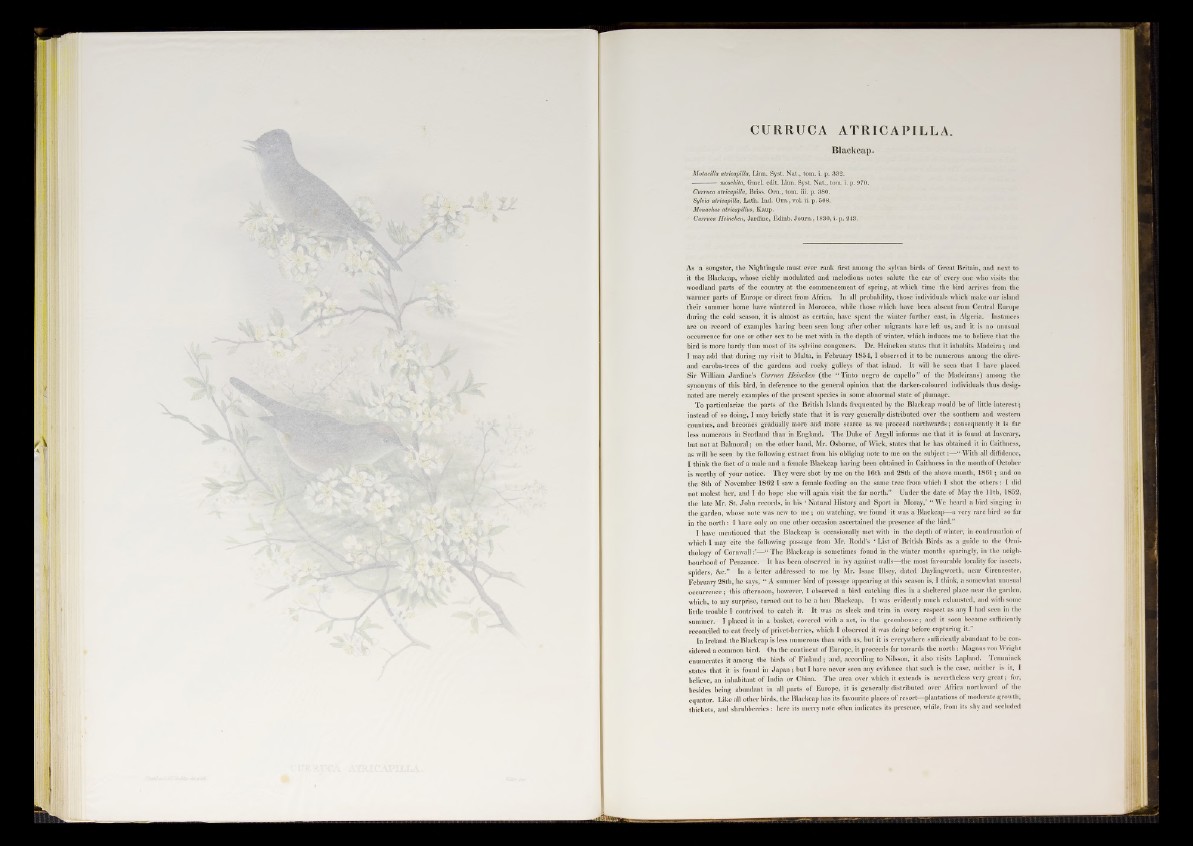
Blackcap.
Motacilla atricapilla, Linn. Syst. Nat., tom. i. p. 332.
------------mosckita, Gmel. edit. Linn. Syst. Nat., tom. i. p. 970.
Curruca atricapilla, Briss. Orn., tom. iii. p. 380.
Sylvia atricapilla, Lath. Ind. Orn., vol. ii. p. 508.
Monachus atricapillus, Kaup.
Curruca Heineken, Jardine, Edinb. Journ., 1830, i. p. 243.
As a songster, the Nightingale must ever rank first among the sylvan birds of Great Britain, and next to
it the Blackcap, whose richly modulated and melodious notes salute the ear of every one who visits the
woodland parts of the country at the commencement of spring, at which time the bird arrives from the
warmer parts of Europe or direct from Africa. In all probability, those individuals which make our island
their summer home have wintered in Morocco, while those which have been absent from Central Europe
during the cold season, it is almost as certain, have spent the winter further east, in Algeria. Instances
are on record o f examples having been seen long after other migrants have left us, and it is no unusual
occurrence for one or other sex to be met with in the depth of winter, which induces me to believe that the
bird is more hardy than most of its sylviine congeners. Dr. Heineken states that it inhabits Madeira; and
I may add that during my visit to Malta, in February 1 8 5 4 ,1 observed it to be numerous among the olive-
and caroba-trees of the gardens and rocky gulleys of that island. It will be seen that I have placed
Sir William Jardine’s Curruca Heineken (the “ Tinto negro de capello” of the Madeirans) among the
synonyms of this bird, in deference to the general opinion that the darker-coloured individuals thus designated
are merely examples of the present species in some abnormal state of plumage.
To particularize the parts of the British Islands frequented by the Blackcap would be of little interest ;
instead of so doing, I may briefly state that it is very generally distributed over the southern and western
counties, and becomes gradually more and more scarce as we proceed northwards; consequently it is far
less numerous in Scotland than in England. The Duke of Argyll informs me that it is found at Inverary,
but not a t Balmoral; on the other hand, Mr. Osborne, of Wick, states that he has obtained it in Caithness,
as will be seen by the following extract from his obliging note to me on the subject:—“ With all diffidence,
I think the fact of a male and a female Blackcap having been obtained in Caithness in the month of October
is worthy of your notice. They were shot by me on the 16th and 28th of the above month, 1861; and on
the 8th of November 1862 I saw a female feeding on the same tree from which I shot the others: I did
not molest her, and I do hope she will again visit the far north.” Under the date of May the 11th, 1852,
the late Mr. St. John records, in his ‘ Natural History and Sport in Moray,’ “ We heard a bird singing in
the garden, whose note was new to me; on watching, we found it was a Blackcap—a very rare bird so far
in the n o rth : I have only on one other occasion ascertained the presence of the bird.”
I have mentioned that the Blackcap is occasionally met with in the depth of winter, in confirmation of
which I may cite the following passage from Mr. Rodd’s ‘ L ist of British Birds as a guide to the Ornithology
of C o rnw a ll—“ The Blackcap is sometimes found in the winter months sparingly, in the neighbourhood
of Penzance. It has been observed in ivy against walls— the most favourable locality for insects,
spiders, &c.” In a letter addressed to me by Mr. Isaac Ulsey, dated Daylingworth, near Cirencester,
February 28th, he says, “ A summer bird of passage appearing a t this season is, I think, a somewhat unusual
occurrence; this afternoon, however, I observed a bird catching flies in a sheltered place near the garden,
which, to my surprise, turned out to be a hen Blackcap. It was evidently much exhausted, and with some
little trouble I contrived to catch it. It was as sleek and trim in every respect as any I had seen in the
summer. I placed it in a basket, covered with a net, in the greenhouse; and it soon became sufficiently
reconciled to eat freely of privet-berries, which I observed it was doing before capturing it.”
In Ireland the Blackcap is less numerous than with us, but it is everywhere sufficiently abundant to be considered
a common bird. On the continent- of Europe, it proceeds far towards the n orth: Magnus von Wright
enumerates it among the birds of Finland; and, according to Nilsson, it also visits Lapland. Temminck
states that it is found in Japan ; but I have never seen any evidence that such is the case, neither is it, I
believe, an inhabitant of India or China. The area over which it extends is nevertheless very g rea t; for,
besides being abundant in all parts of Europe, it is generally distributed over Africa northward of the
equator. Like all other birds, the Blackcap has its favourite places of resort—plantations o f moderate growth,
thickets, and shrubberries: here its merry note often indicates its presence, while, from its shy and secluded